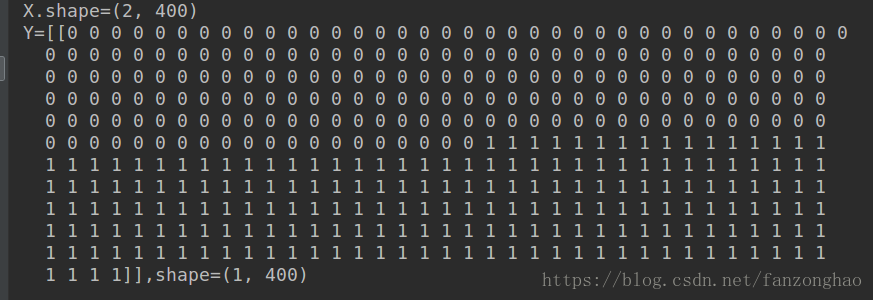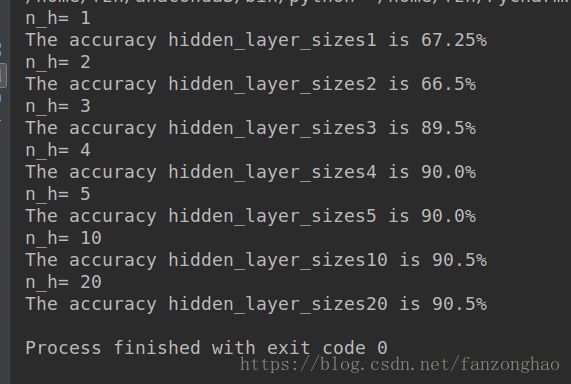吴恩达作业2 利用两层神经网络实现不同颜色点的分类,可更改隐藏层数量
任务:将400个两种颜色的点用背景色分为两类。
前面的还是建议重点学神经网络知识,至于数据集怎么做的后面在深究,首先先看看数据集,代码如下:
def load_planar_dataset():
np.random.seed(1)
m = 400 # number of examples
N = int(m/2) # number of points per class
D = 2 # dimensionality
X = np.zeros((m,D)) # data matrix where each row is a single example
Y = np.zeros((m,1), dtype='uint8') # labels vector (0 for red, 1 for blue)
a = 4 # maximum ray of the flower
for j in range(2):
ix = range(N*j,N*(j+1))
t = np.linspace(j*3.12,(j+1)*3.12,N) + np.random.randn(N)*0.2 # theta
r = a*np.sin(4*t) + np.random.randn(N)*0.2 # radius
X[ix] = np.c_[r*np.sin(t), r*np.cos(t)]
Y[ix] = j
X = X.T
Y = Y.T
return X, Y打印看看返回的X,Y
由于X太多不方便粘贴,只打印了shape,可看出X是2行400列的矩阵(2,400),Y是1行400列矩阵(1,400)。
然后用X的数据作为二维的坐标点,Y的0,1作为分类点,比如0代表红色点,1代表蓝色点,这样400个两种颜色的点就可以显示出来,代码如下:
"""
测试函数:实现数据集的显示
"""
def test():
X,Y=planar_utils.load_planar_dataset()
plt.scatter(X[0,:],X[1,:],c=np.squeeze(Y),s = 80,cmap=plt.cm.Spectral)
plt.show()显示结果如下:
利用两层神经网络,一层隐藏层,一层输出层,400个点,所以有400个样本,两种特征(两种颜色),所以输入层节点是2个,隐藏层定义4个节点,输出层1个节点,脑海里就有神经网络的结构图了,故W1(4,2),b1(4,1),W2(1,4),b2(1,1)简单的演示一遍。Z1=W1*X=(4,400),Z2=W2*Z1=(1,400),就对应Y的维度了。中间加激活函数和b值不影响维度
具体公式推导如下,右上角是神经网络:
下面看代码:
def sigmoid(z):
s=1.0/(1+np.exp(-z))
return s
"""
返回输入层节点和输出层节点
"""
def lay_sizer(X,Y):
n_x = X.shape[0]
n_y = Y.shape[0]
return n_x,n_y
"""
初始化W和b,n_h就是隐藏层节点
"""
def initialize_parameters(n_x,n_h,n_y):
W1 = np.random.randn(n_h,n_x)*0.01
b1=np.zeros((n_h,1))
W2 = np.random.randn(n_y, n_h) * 0.01
b2 = np.zeros((n_y, 1))
parameters={'W1':W1,
'b1':b1,
'W2':W2,
'b2':b2}
return parameters
"""
前向传播,返回中间量Z1 A1 Z2 A2 最后一层加sigmoid因为要实现二分类
"""
def forward_propagation(X,parameters):
W1 = parameters['W1']
W2 = parameters['W2']
b1 = parameters['b1']
b2 = parameters['b2']
Z1 = np.dot(W1, X) + b1
A1 = np.tanh(Z1)#Relu(Z1)
Z2 = np.dot(W2, A1) + b2
A2 = sigmoid(Z2)
cache={'Z1':Z1,
'Z2':Z2,
'A1':A1,
'A2':A2}
return cache,A2
"""
利用交叉熵函数计算损失值
"""
def compute_cost(A2,Y):
m=Y.shape[1]
cost=-1 / m *(np.dot(Y,np.log(A2).T)+np.dot((1-Y),np.log(1-A2).T))
cost=np.squeeze(cost)
return cost
"""
后向传播:注意维度
"""
def back_propagation(parameters,cache,X,Y):
m = Y.shape[1]
A2 = cache['A2']
A1 = cache['A1']
W2 = parameters['W2']
dZ2 = A2-Y
dW2 = 1/m*(np.dot(dZ2,A1.T))
db2 = 1/m*(np.sum(dZ2,axis=1,keepdims=True)) #db2(n_y,1) 按行相加 保持二维性
# [[1,2],[3,4]] [[3],[7]]
dA1 = np.dot(W2.T,dZ2)
dZ1 = dA1*(1-np.power(A1,2))
dW1 = 1/m*np.dot(dZ1,X.T)
db1 = 1/m*(np.sum(dZ1,axis=1,keepdims=True)) #db1(n_h,1) 按行相加 保持二维性
grads={'dW2':dW2,
'dW1':dW1,
'db2':db2,
'db1':db1}
return grads
"""
更新参数 W和b
"""
def update_parameters(grads,parameters,learning_rate):
dW2=grads['dW2']
dW1=grads['dW1']
db2=grads['db2']
db1=grads['db1']
W2=parameters['W2']
W1= parameters['W1']
b2 = parameters['b2']
b1 = parameters['b1']
W2 = W2 - learning_rate*dW2
W1 = W1 - learning_rate * dW1
b2 = b2 - learning_rate * db2
b1 = b1 - learning_rate * db1
parameters = {'W1': W1,
'b1': b1,
'W2': W2,
'b2': b2}
return parameters
"""
构建模型
"""
def nn_model(X,Y,num_iterations,learning_rate,print_cost,n_h):
n_x,n_y = lay_sizer(X, Y)
parameters = initialize_parameters(n_x, n_h, n_y)
#costs=[]
for i in range(num_iterations):
cache, A2 = forward_propagation(X, parameters)
cost = compute_cost(A2, Y)
#costs.append(cost)
grads = back_propagation(parameters, cache, X,Y)
parameters = update_parameters(grads, parameters, learning_rate)
if print_cost and i%100==0:
print('Cost after iterations {}:{}'.format(i,cost))
return parameters #,costs
"""
用更新好的参数预测Y值
"""
def prediction(X,parameters):
cache,A2=forward_propagation(X,parameters)
predictions=np.around(A2)
return predictions
def train_accuracy():
X, Y = planar_utils.load_planar_dataset()
parameters = nn_model(X, Y, num_iterations=10000, learning_rate=1.2, print_cost=True,n_h=8)
# print('parameters W1', parameters['W1'])
# print('parameters W2', parameters['W2'])
# print('parameters b1', parameters['b1'])
# print('parameters b2', parameters['b2'])
predictions = prediction(X, parameters)
print(predictions)
planar_utils.plot_decision_boundary(lambda x: prediction(x.T, parameters), X, np.squeeze(Y))
plt.show()
###########二分类精度求解
result = np.dot(np.squeeze(Y), np.squeeze(predictions.T)) + np.dot(np.squeeze(1 - Y), np.squeeze(1 - predictions.T))
print('The accuracy is {}%'.format((result) / Y.size * 100))
if __name__=='__main__':
#test()
train_accuracy()结果:
更改隐藏层个数:
def Different_Hidden_Size():
X, Y = planar_utils.load_planar_dataset()
hidden_layer_sizes=[1,2,3,4,5,10,20]
plt.figure(figsize=(16,16))
for i,n_h in enumerate(hidden_layer_sizes):
print('n_h=',n_h)
plt.subplot(3,3,i+1)
plt.title('hidden_layer_sizes{}'.format(n_h))
parameters = nn_model(X, Y, num_iterations=2000, learning_rate=1.2, print_cost=False,n_h=n_h)
planar_utils.plot_decision_boundary(lambda x: prediction(x.T, parameters), X, np.squeeze(Y))
predictions = prediction(X, parameters)
###########二分类精度求解
result = np.dot(np.squeeze(Y), np.squeeze(predictions.T)) + np.dot(np.squeeze(1 - Y),
np.squeeze(1 - predictions.T))
print('The accuracy hidden_layer_sizes{} is {}%'.format(n_h,(result) / Y.size * 100))
plt.savefig('1.png')
plt.show()if __name__=='__main__':
#test()
#train_accuracy()
Different_Hidden_Size()结果:







